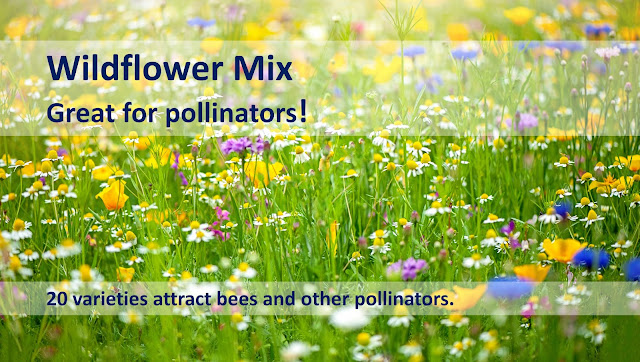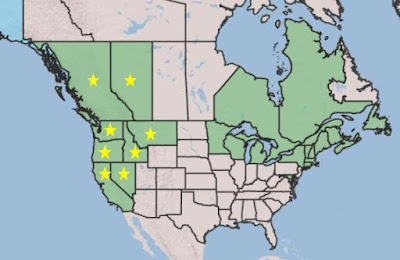 |
| A single flower emerges between a pair of leaves of wild ginger, Asarum canadense. |
In spring, wild ginger is one of
the first plants to emerge on the deciduous forest floor. Softly hairy leaves grow
in pairs from shallow rhizomes, eventually expanding into heart- or
kidney-shaped blades 3-5 inches wide. Mature petioles, or leaf stalks, are
several inches long, and like the leaves, they are finely white-hairy. To an
imaginative observer, they resemble pipe cleaners.
A single, reddish-brown, tubular
flower develops in the axil of each pair of leaves. The flower is close to the ground on a slightly bent peduncle, or flower stalk. The
flower has no petals, but its three, long-pointed sepal resemble petals and curve back
over an open floral cup.
Inside the cup, the stigmas – the parts
that receive pollen – mature first. They’re in the center of the flower,
supported by their styles and surrounded by 12 stamens. Initially the stamens bend
down and away from the stigmas, their pollen-bearing anthers lying parallel
with the bottom of the cup. Over several days, the stamens straighten.
 |
| This dissected flower shows a central column of several upright stamens (solid arrow) surrounding stigmas and styles, which are hidden. The whitish dust around the top of the column is pollen. Several anthers still rest on the bottom of the cup (dashed arrow). |
 |
Left: A flower with most stamens upright and a few still lying on the bottom of the floral cup.
Right: An older flower with all stamens upright. |
A Pollination Puzzle
Pollination is a bit of a mystery.
Many general references say the flowers are pollinated by flies and ground
beetles attracted to the flowers’ fleshy color and supposed rotting-meat odor. As it
turns out, that’s an assumption passed from one reference to the next, but it’s
easy to see why it persisted.
Wild ginger doesn’t look like
something pollinated by bees or butterflies. Although the flowers are beautiful
in their details, they’re generally drab and mostly hidden under the leaves. They
don’t look anything like the brightly colored, conspicuous flowers typically
pollinated by bees or butterflies. Instead, their maroon to brown color matches
that of animal flesh, like the flowers of some other plants pollinated by flies.
 |
| The bright yellow flowers of marsh marigold (Caltha palustris), left, are typical those pollinated by bees and other insects. The flower structure of skunk cabbage, center, looks and smells like decaying animal flesh and is pollinated by flies. Wild ginger, right, more closely resembles a fly-pollinated flower, at least in color. Photos not to scale. Skunk cabbage photo © 2009 Katy Chayka at Minnesota Wildflowers, used with permission granted on the website. |
Skunk cabbage (Symplocarpus
foetidus), another Minnesota native, is a good example. It emerges in late
winter or very early spring, even while snow covers the ground. Its flowering
structure is a reddish-brown, leaf-like spathe enclosing a club of flowers
called a spadix. As the plant’s name suggests, the structure has a fetid, dead-skunk
smell. The small flowers on the spadix are pollinated by flies and beetles drawn
to the plant’s carrion-like color and odor.
Other Evidence
Wild ginger doesn’t smell that
bad. A sniff test finds that, at worst, the flowers can have a slightly
unpleasant odor, but they don’t smell so strongly of rotting carcass that you
would recoil. “Earthy” might be the best word to describe it. Some even say the
flowers have a sweet smell. In any case, they aren’t obvious fly bait.
Early studies of wild ginger find
other contradictions with the fly-pollination hypothesis. In the late 1940s,
Harvey E. Wildman of the University of West Virginia experimented with wild
ginger flowers to answer the question of how they’re pollinated (1). He removed
the stamens from one group of flowers and left another group intact. In each
group, he covered some of the flowers in wax paper bags (after ensuring no
insects were inside the flowers) and left others uncovered. After several
weeks, he checked the flowers for seed development.
None of the flowers with stamens
removed, even those that were uncovered, developed seeds. In fact, all such
flowers he checked had either fallen off or withered. In contrast, most of the
flowers left intact developed “sound seeds.” That includes the ones that were
covered. Wildman also reported that few insects were found inside any of the
flowers.
If the flowers were strictly cross-pollinated
by flies or other insects, at least some of the uncovered ones without stamens would
have developed seeds, because something would have brought pollen to their
stigmas. At the same time, the intact, covered flowers would not have developed
seeds, because insects did not have access. Wildman concluded that wild ginger
is primarily self-pollinated, not cross-pollinated.
Timed for Cross-Pollination?
Although Wildman’s experiment is illuminating,
pollination is still a head-scratcher. One way plants foster cross-pollination
is by staggering the development of stigmas and anthers inside a single flower,
and wild ginger does exactly that. As mentioned above, the stigmas mature first, Eventually the
filaments and anthers straighten and approach the stigmas, but not before the
flowers have had a chance to receive pollen from another plant. This suggests
that self-pollination is a back-up rather than a primary means of
fertilization. Are we missing a pollinator?
Whether self-pollinated or somehow
cross-pollinated, fertilized flowers later develop
seeds within capsules. When the capsules open in mid-summer, they expose small
seeds with tiny fat bodies attached. The bodies, called elaiosomes
(e-LY-oh-somes or e-LAY-oh-somes) attract ants, which carry the seeds back to a
nest, eat the elaiosomes or feed them to their young, and leave the seeds to
germinate, safely out of reach of seed predators. Seeds can also fall next to
the parent plant and germinate there.
 |
| Left: The swollen ovary at the base of the flower indicates that this flower has been fertilized. Center: The same flower viewed from above. Each of the twelve dots around the center is what remains of a stamen. Right: Seeds are released in mid-summer. Each is just a few millimeters wide and long, with a golden-brown elaiosome attached. |
Rhizomes for Spread, Not for
Spice
 |
| A rhizome of wild ginger (arrow). |
If its seeds don’t succeed in
helping wild ginger reproduce, its rhizomes can. (See the previous post for more
about rhizomes.) The plant is almost aggressive in its vegetative spread,
quickly filling suitable habitat, especially where it has limited competition.
Many say the rhizomes are aromatic
and ginger-y in smell and taste. Although they have a long history of use as
medicine and flavoring, ingesting them in any form is discouraged now. Wild
ginger rhizomes and other parts have been found to contain variable amounts of aristolochic
acid, a compound known to damage kidneys and perhaps cause cancer (2, 3). Handling
the plants can also cause dermatitis.
This isn’t true of ginger roots (rhizomes)
or ginger spice found in grocery stores. Culinary ginger is “true” ginger, Zingiber
officinale, a tropical plant. It is not related to Asarum canadense.
Where to Find Wild Ginger
Wild ginger is native to deciduous and mixed deciduous-coniferous forests. It prefers full to part shade and moist, humus-rich soils. It wilts in prolonged drought.
 |
| Wild ginger range in the upper Midwest and North America. Maps from USDA NRCS Plants Database (4). |
Cited References
1)
Wildman,
Harvey E. 1950. Pollination of Asarum Canadense L. Science 111 (2890): 551. http://www.jstor.org/stable/1676584.
2)
McMillin,
D.L., Nelson, C.D., Richards, D.G., and Mein, E.A. 2003. Research Report: Determination of
Aristolochic Acid in Asarum canadense (Wild Ginger). Meridian Institute.
3)
Qingqing
Zhou, et al. 2023. Overview of aristolochic acid nephropathy:
an update. Kidney Res
Clin Pract 42 (5): 579-590.
4)
USDA, NRCS. 2024. The PLANTS Database
(http://plants.usda.gov, 05/01/2024). National Plant Data Team, Greensboro, NC
USA.
Other References and More Information
Anderson, M.K. Ed. 2000, 2003 and
2006. Plant
Guide: Canadian Wildginger. USDA NRCS National Plant Data
Center, Davis, California.
Baskin, J. M., & Baskin, C. C. 1986. Seed Germination
Ecophysiology of the Woodland Herb Asarum canadense. The American Midland
Naturalist, 116 (1), 132–139. https://doi.org/10.2307/2425945
Dunphy, S.A. Meadley, K. M. Prior,
and M.E. Frederickson. 2016. An
invasive slug exploits an ant-seed dispersal mutualism. Oecologia 181:
149-159. DOI 10.1007/s00442-015-3530-0 .
Hayden, W. John. 2010. Don't
Judge a Book by its Cover: The Curious Case of Wild Ginger Pollination.
Bulletin of the Virginia Native Plant Society 29 (1): 1, 6.
Schultz, K. 2014. Using shade to
propagate Canadian wild ginger (Asarum canadense L.) and other woodland
forbs. Native Plants Journal 15 (3): 231-235. DOI: https://doi.org/10.3368/npj.15.3.231.
Stritch, L. No date. Plant
of the Week: Wild Ginger (Asarum canadense L.). USDA, US Forest
Service.
































